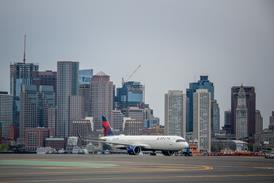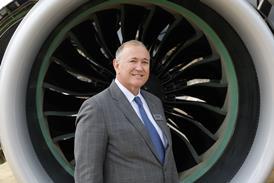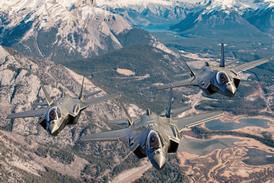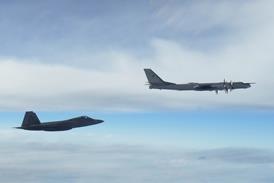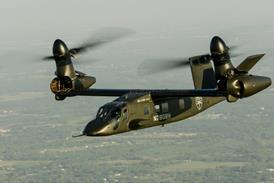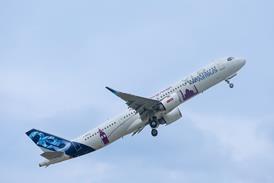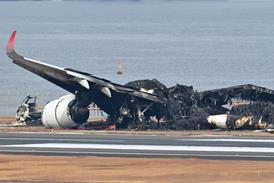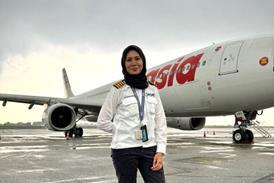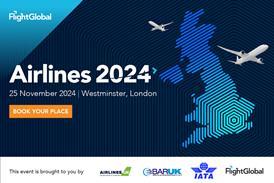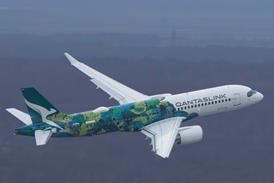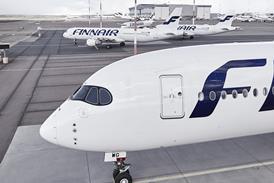COLIN BAKER LONDON
Despite agreement of a new Chapter 4 standard, the threat of a transatlantic split on engine noise looms large.
The world now has a new standard for engine noise, and that in itself is a significant landmark. It is more than two decades since the world last agreed such standards. That was back in 1977 when Chapter 3 was drawn up under the auspices of the International Civil Aviation Organisation (ICAO). But agreement on a long-term technical standard may prove to be the simple part. The most bitter political arguments have been reserved for the issue of whether and when to phase out those aircraft/engine combinations already at the bottom of the Chapter 3 league table.
A new Chapter 4 was finally laid out at the end of January as ICAO's fifth Committee on Aviation Environmental Protection (CAEP) reached unanimous agreement: limits will be 10dB quieter than the old ones of Chapter 3 - or Stage 3 as it became in US legislation. Although the new standard only applies to aircraft built after 2006 and should have little impact on current types, it comes as a timely reminder that the noise issue is here to stay.
Even before Chapter 4 was agreed, it was already clear that Brussels and Washington diverged fundamentally on what to do about operating restrictions on the noisiest Chapter 3 engines. The aim is to reach a compromise on phase-out by the time of ICAO's next triennial general assembly in around six months. That looks ambitious. In simple terms, Europe is pushing for an early phase-out of the noisiest Chapter 3 engines. Washington is against any phase-out at all and argues that regionalisation of engine noise limits would impede international aviation.
"It has been shown by cost benefits analysis that a phase-out is not justified," says Clay Foushee, vice-president regulatory affairs at Northwest Airlines. The US side argues that there is too much concentration on engine noise. "We need a balanced approach. It is not just about noise at source," says Foushee. Hecites land use, noise mitigation, and operational procedures as areas which should receive more attention.
That European airports tend to be much nearer population centres is an underlying theme in this debate. Pressure is growing from local protest groups springing up all over Europe, and Brussels wants to head off the risk of a plethora of different airport standards being applied at regional level. However, Nancy Young, director of international environment at the club for US majors, the Air Transport Association, points out that it was agreed at CAEP that the new stringencies should be used for certification purposes only - and not as a basis for operating restrictions at airports.
Europe and the USA have long been at loggerheads over noise standards. Existing tensions over Airbus and Boeing have not helped, while there are also suspicions in Europe that Washington is reacting badly to the sight of Brussels now flexing its regulatory muscles. "Washington was quite happy when they were unilaterally head of the game," notes one European lawyer.
ICAO insiders also believe that Washington may have cause to fear a backlash at home if Europe goes its alone. "They are worried that people will start asking why, if it's good enough for the Europeans, it's not good enough for them," says one senior official.
Transatlantic tension
Given this background, it is understandable that the talks at CAEP 5 were tense, with neither side giving much ground. What seems to have really riled the European contingent, however, was the proposal from the US side that noise regulations would simply vary by airport. "We cannot accept the US suggestion that we look at operating restrictions on an airport-by-airport basis," warns Eckard Seebohm, who oversees airport policy at the European Commission (EC). He argues that the US tends to place too much emphasis on setting minimum requirements, while airports in Europe want to go much further.
To ward off this threat, the EC is keen to see an end to those aircraft that just scrape into Chapter 3. It is targeting aircraft that make the standard by less than 5dB (all are based on the usual cumulative measurements taken at three points). This would take in most of the world's hushkit fleet, which currently stands at just over 1,900 aircraft. In total it would affect some 3,500 western-built aircraft currently serving in the world fleet.
So, despite the agreement on a new noise standard, the issue of regulation remains far from clear, largely due to this transatlantic rift. Last time around, when Chapter 3 was being introduced, things were much simpler. Washington, Brussels and most industrialised nations were in broad agreement on the new standard and the phase-out of Chapter2 engines.
| Total world hushkit fleet | |||
| Region | Number | Proportion | |
| North America | 1.486 | 77.8% | |
| European Union | 135 | 7.1% | |
| Africa | 119 | 6.2% | |
| Latin America/Carribean | 103 | 5.4% | |
| Asia | 49 | 2.6% | |
| Europe non-EU | 17 | 0.9% | |
| Grand Total | 1,909 | 100% | |
| Top five European Union hushkit users | |||
| Rank | Operator | Number | Proportion |
| 1 | SAS | 17 | 12.6% |
| 2 | European air charter | 16 | 11.9% |
| 3 | European air transport | 15 | 11.1% |
| 4 | Iberia | 11 | 8.1% |
| 5 | Ryanair | 11 | 8.1% |
| Subtotal top five | 70 | 51.9% | |
| Total European Union hushkit fleet | 135 | 100% | |
| Top 10 North American hushkit operators | |||
| Rank | Operator | Number | Proportion |
| 1 | Northwest Airlines | 202 | 13.6% |
| 2 | Delta Air Lines | 143 | 9.6% |
| 3 | FedEx | 138 | 9.3% |
| 4 | Airborne Express | 108 | 7.3% |
| 5 | United Airlines | 99 | 6.7% |
| 6 | US Airways | 78 | 5.2% |
| 7 | Kitty Hawk Air Cargo | 42 | 2.8% |
| 8 | AirTran Airways | 38 | 2.6% |
| 9 | Canadian Airlines | 36 | 2.4% |
| 10 | Southwest Airlines | 33 | 2.2% |
| Subtotal top 10 | 917 | 61.7% | |
| Total North America | 1,486 | 100% | |
| Source: Airclaims CASE | |||
ICAO has little power of compulsion, leaving contracting states much freedom in how they implement regulations, as long as they do not break any ICAO conventions. When there is broad overall agreement, as with the Chapter 2 phase-out, this meant that the developed world could introduce broadly homogeneous rules on engine noise. Today politicians seem less in the mood for consensus.
The divergence of opinion between Brussels and Washington could yet result in different engine noise regulations on either side of the Atlantic. "If agreement cannot be reached we will not sit back and wait for the next ICAO assembly," warns Seebohm. Indeed, He points out that the Europeans made clear their dissatisfaction with assembly resolutions on noise at the last ICAO assembly three years ago in 1998.
Seebohm notes that the EC, like the USA, has a free hand with its "domestic" (intra-European) traffic. The example he uses to make his point is, perhaps not coincidentally, the early phase-out of Chapter 2 engines in the USA for domestic traffic. There the cut-off date was moved forward to 2000 from 2002. Seebohm points out that the proportion of non-domestic traffic in the European Union (EU) is much higher than in the USA. As a result, he says, restrictions on intra-EU traffic would have only a limited effect.
This leaves open the possibility of the Europeans, along with Australia, going it alone in introducing operating restrictions for marginal Chapter 3 aircraft. The question is, as one ICAO insider puts it: "Will the rest of the world allow this to happen?" It was agreed at CAEP 5 that noise rules should exempt the developing world and be non-discriminatory to any particular region. These are little more than formalities but may yet form the basis of legal wrangles to come.
Hushkit row
Last year's much-publicised row over Europe's "hushkits ban", has in many ways been a dry run for the disagreements at CAEP5. Brussels plans to outlaw hushkitted aircraft from April next year, unless they have a EU operating history prior to May 2000. The USA believes this unfairly discriminates against the US airline and aerospace industries, and filed a complaint under Article 84 of the Chicago Convention.
Brussels failed to have the complaint thrown out and the issue is grinding its way through the ICAO procedural process. "Article 84 was hanging over the negotiations. There was tremendous political pressure and both sides took very rigid positions," says an ICAO insider. Most observers presume the hushkit row is closely linked to the CAEP talks and that if agreement on what to do with the noisier Chapter 3 engines can be reached, the issue will die. "If not, a certain hardening of the situation may have to be anticipated," warns Seebohm.
The uncompromising stance on hushkits is in part due to the fact that the outcome will have a major bearing on the Chapter 3 phase-out debate. The central issue in both cases is the same - can the Europeans go it alone? In the meantime, both parties in the hushkit row have accepted mediation from ICAO president, Dr Assad Kotaite. Chances of any resolution before the 33rd assembly are seen as slim.
Although restrictions on Chapter 3 engines remains a major stumbling block, the agreement of a new Chapter 4 standard (at 10dB quieter than Chapter 3) was much more positive, even if Brussels does not appear entirely satisfied with the outcome. "It was better than nothing. It was better than 8dB which was one option," says an EC official.
Indeed, and 8dB improvement, which was seen as the lowest possible option, was put forward by the US side at CAEP. Intriguingly, the Americans are understood to have been supported by at least some European states giving backing to their Airbus manufacturing plants.
The Airports Council International (ACI) was pushing for a14dB decrease to Chapter 3, and, not surprisingly, was less than happy with the outcome. John Hume, director of policy at ACI Europe, warns: "We made clear we are deeply disappointed. Cumulative 10dB offers no relief to airports from the pressures at local and European Parliament level."
Indeed, Hume says that "green"environmental elements within the European Parliament are turning up the heat on airports. Shortly before Christmas, ACI Europe narrowly managed to block at the first reading stage a proposal which would have set out airport noise limit targets across the EU for 2006, 2012 and 2020. Hume says the 2020 limits would have meant airports would have to operate within noise limits set for public libraries: "Either airport operators would have had to buy up huge housing estates, go to jail or close down."
If the proposal had reached a second reading, then it is likely that a compromise solution would have been reached - which would have still meant much tougher noise regulation for airports. Although ACI Europe was successful this time around, Hume warns that the problem has not gone away: "A substantial result from CAEP would have helped," he says.
Noise timeframe
Meanwhile, the CAEP 5 recommendations have been sent to the different ICAO bodies for analysis. The organisation's navigation committee will examine the technical aspects of the proposals, while the air transport committee will look at the economic aspects (such as market-based solutions).
This part of the process is likely to be completed some time in March, after which the recommended standards will be sent out to the Contracting States for comment. "There is unlikely to be a challenge at this point," an ICAO insider confidently predicts.
There will be further meetings at ICAO in April and June, although, in practice, the work towards achieving some form of agreement before the autumn assembly will be more or less continuous. The talks will be complex as well as fraught, given the multitude of overlapping parameters involved. These include phase-out dates, phase-out timeframes, minimum aircraft lifespan (last time round it was 25 years) and take-off and landing cycles. So, even if they can agree on a phase-out, getting agreement on whether to give priority to minimum lifespan or maximum number of cycles will be far from easy.
If agreement cannot be reached by around September there is the real prospect of a split in international engine noise standards among the industrialised world, with the EU and Australia phasing out the noisiest Chapter 3 engines. Brussels insiders say this could happen some time after the 2002 deadline for Chapter 2phase-out. "We should continue to restrict the noisiest aircraft without a long break. Certainly 2006 is too long," says one.
ICAO insiders admit that only optimists were expecting agreement on Chapter 3 restrictions at CAEP 5. There is no shortage of pessimists predicting that there will be no agreement by the time of the next ICAO assembly. If they are right this could have dire implications for transatlantic relations on aviation if for nothing else.
Source: Airline Business


